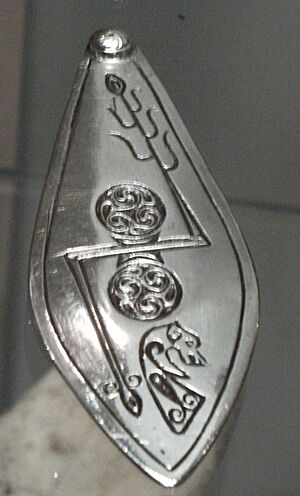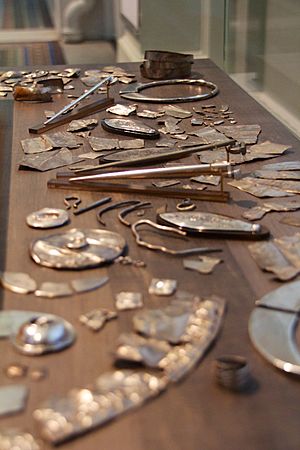Norrie's Law hoard facts for kids
Quick facts for kids Norrie's Law Hoard |
|
|---|---|

Silver plaque, Norrie's Law Hoard
|
|
| Material | Silver |
| Created | c.500 - 600 AD |
| Discovered | c.1819 Upper Largo, Scotland 56°14′30″N 2°56′21″W / 56.2416°N 2.9393°W |
| Present location | National Museum of Scotland |
The Norrie's Law hoard is a collection of ancient silver items. It was found in 1819 near a small mound in Largo, Fife, Scotland. This amazing treasure dates back to the 500s AD.
Someone found the hoard while digging, but most of it was sold or given away. Later, more items were found and given to the landowner, General Philip Durham. Today, the surviving 170 pieces of the hoard are kept at the National Museum of Scotland. The treasure mostly contains pieces of cut silver, called hacksilver. It also includes four complete silver objects.
What Was Found in the Norrie's Law Hoard?
The Norrie's Law hoard is one of the biggest Pictish treasures ever discovered. When it was first found, it had about 12.5 kilograms (27.5 pounds) of silver. This silver came from both late Roman times and the Picts.
Sadly, less than 1 kilogram (2.2 pounds) of the original hoard remains today. The 170 pieces that are left are mostly hacksilver. This means they are pieces of silver that were cut up. People used hacksilver for its silver value, often trading it or melting it down to make new things.
The hoard also includes some complete silver objects. These are:
- A penannular brooch (a type of pin for clothes).
- A leaf-shaped oval plaque with special Pictish symbols.
- A large hand-pin.
- A worn spiral finger-ring.
Some incomplete items were also found. These include parts of a Roman spoon, pieces of silver sheet from a plate, and broken spiral bracelets. The hoard also had two Late Roman coins. However, these coins were melted down and sold soon after the hoard was first found.
How the Norrie's Law Hoard Was Discovered
The Norrie's Law hoard was found in 1819. The person who found it is unknown. It was discovered at a small mound called Norrie's Law. This mound was on the Largo Estate in Fife.
The mound was made of stones and sat on a raised bank of sand and gravel. The discovery happened when the finder was digging for sand at the bottom of the mound. The silver found was given to a peddler, who then sold most of it as scrap silver. Some pieces were also given away.
The landowner, General Durham, found out about the hoard after most of the silver was gone. He managed to find the remaining items that had not been found in the first digging. General Durham kept the discovery a secret for 20 years.
In 1839, a local historian named George Buist looked into stories about the hoard. He then wrote about the discovery for a local history group. Buist had copies made of two important items from the hoard: the decorated plaque and the large hand-pin. These copies were made of pewter.
General Durham passed away in 1845 without any children. The Largo estate went to Lilas Dundas Calderwood Durham. In 1864, she gave most of the remaining hoard pieces to the Museum of Society of Antiquaries of Scotland. This museum is now the National Museum of Scotland. The rest of the hoard was given to the museum by her heir, Robert Dundas of Arniston, in 1883.
When Was the Hoard Buried?
The hoard contained Roman coins from the fourth century. This suggests that the hoard must have been buried sometime after the early 400s AD.
More recent studies have been done by the Glenmorangie Research Project. This project is at the National Museum of Scotland. Their research suggests that the hoard was buried in the sixth century AD (the 500s).
The study also found that two silver copies of hoard items were made around 1839. These silver copies were of the Pictish-decorated plaque and the large hand-pin. Until recently, people thought these silver copies were original ancient metalwork.


